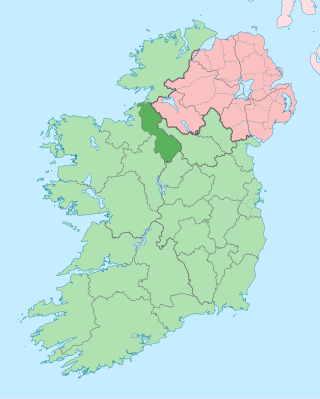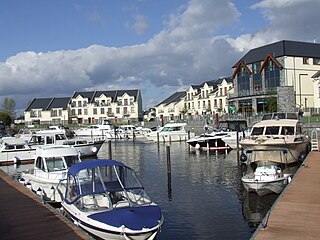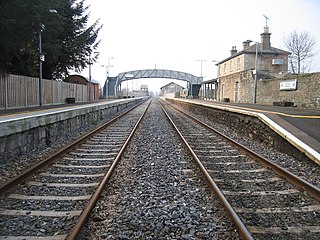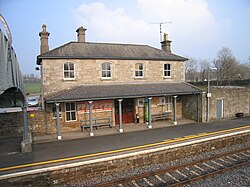
County Leitrim is a county in Ireland. It is in the province of Connacht and is part of the Northern and Western Region. It is named after the village of Leitrim. Leitrim County Council is the local authority for the county, which had a population of 35,199 according to the 2022 census.

Carrick-on-Shannon is the county town of County Leitrim in Ireland. It is the largest town in the county. A smaller part of the town located on the west bank of the River Shannon lies in County Roscommon and is home to the towns main train station. As of the 2022 census, the population of the town was 4,743. It is situated on a strategic crossing point of the River Shannon. The main part of the town, the County Leitrim part, is in the civil parish of Kiltoghert, which is in the barony of Leitrim, while Cortober, which is the County Roscommon side of the town, is in the civil parish of Killukin, in the barony of Boyle.

Ballinamore is a small town in the south-east of County Leitrim in Ireland.

Mohill is a town in County Leitrim, Ireland. The town of Carrick-on-Shannon is approximately 16 km (10 miles) away.

Roosky, Ruskey, or Rooskey is a village on the River Shannon in the northern midlands of Ireland, near the point where counties Leitrim, Longford, and Roscommon meet. The N4 road from Dublin to Sligo passes by the Leitrim side of the village.

Drumsna is a village in County Leitrim, Ireland. It is situated 6 km east of Carrick-on-Shannon on the River Shannon and is located off the N4 National primary route which links Dublin and Sligo. The harbour dates to 1817 and was a hive of commercial waterway activity until the more northern navigation canal to Carrick-on-Shannon was opened in 1850. Today, the waterway is busy with anglers and tourist pursuits in the summer months.

Leitrim is a village in County Leitrim, Ireland, on the River Shannon near the border with County Roscommon. It is at the junction of the R280 and R284 regional roads.

The Conmaicne, or Conmhaicne were a people of early Ireland, perhaps related to the Laigin, who dispersed to various parts of Ireland. They settled in Connacht and Longford, giving their name to several Conmaicne territories. T. F. O'Rahilly's assertion the Conmaicne were non-Goidelic is not widely accepted.

Glenfarne or Glenfarn is a village in north County Leitrim, Ireland. It is the site of the original 'Ballroom of Romance', which inspired a short story by William Trevor that was subsequently turned into a television film in a BBC/RTÉ co-production. Glenfarne has a lakeside forest near Lough MacNean. The village is located on the N16 (Sligo–Blacklion) road, 13 km east of Manorhamilton.

The Cavan and Leitrim Railway was a 3 ft narrow-gauge railway in the counties of Leitrim and Cavan in northwest Ireland, which ran from 1887 until 1959. Unusually for Ireland, this 3 ft narrow gauge line survived on coal traffic, from the mine at Arigna, although the original main line was constructed principally for traffic in cattle. It outlived most of the other Irish narrow-gauge lines, giving a further lease of life to some of their redundant engines.

Dromod railway station serves the village of Dromod in County Leitrim and nearby Roosky in County Roscommon. It is a station on the Dublin Connolly to Sligo InterCity service.

The R202 road is a regional road in Ireland linking Dromod in County Leitrim to Swanlinbar in County Cavan. En route it passes through Mohill and Ballinamore.

The A32 is a route in Northern Ireland connecting Omagh, County Tyrone and Swanlinbar, County Cavan. The road passes through Dromore in Tyrone and the Fermanagh towns of Irvinestown and Enniskillen.

The Muintir Eolais of Conmaicne Réin were nobles of Gaelic Ireland. For seven hundred years from the 8th century, they lived in and ruled an area roughly conterminous with present-day south County Leitrim. Their territory comprised the lands named Maigh Nissi and Maigh Rein, today the baronies of Leitrim and Mohill respectively.

The barony of Mohill is an ancient barony in County Leitrim, Ireland.
Sliabh an Iarainn, anglicized Slieve Anierin, is a mountain in County Leitrim, Ireland. It rises to 585 metres (1,919 ft) and lies east of Lough Allen and northeast of Drumshanbo. It is part of the Cuilcagh Mountains. The mountain was shaped by the southwestward movement of ice age glaciers over millions of years, the morainic drift heaping thousands of drumlins in the surrounding lowlands. Historically there were many iron ore deposits and ironworks in the area. Irish mythology associates the mountain with the Tuatha Dé Danann, particularly the smith god Goibniu. Sliabh an Iarainn is an important natural heritage site with exposed marine and coastal fauna of paleontological interest
Eolaismac Biobhsach was a chieftain of 10th century Gaelic Ireland. He is noted as the first "full chieftain of the Conmaicne" of present-day south county Leitrim, and parts of west County Longford. His descendants are known as "the Muintir Eolais".
The monastery of Mohill-Manchan was anciently located at Mohill, in county Leitrim. The earliest church was founded by Manchán of Mohill in the 6th century. Little is known about the former monastic community here. About the year 1216, the monastery became a religious house of the Canons Regular of Saint Augustine dedicated to the Saint Mary until suppression c. 1550 – c. 1590. The Priory of Mohill was briefly revived during Confederate Ireland rule but suppressed again by Cromwellian forces c. 1649–1653. From the ruins St. Mary's Church, Mohill, of Protestant denomination, was established in the 18th century.
The Cluain Conmhaícne, or Cluain Conmaicne, were an early people of Ireland. Their tuath comprised the entire parish of Cloone, located in the baronies of Maigh Rein (Mohill) and Carrigallen, in south County Leitrim.
O'Rourke's Castle is a ruined castle in Ireland. It was situated in the centre of Leitrim Village c. 30m from the N bank of the Ballinamore and Ballyconnell canal, which at this point is a canalised stream, and c. 400m from its junction with the River Shannon.


















